#vincent augustus
Explore tagged Tumblr posts
Text

i commissioned @not-another-robin for some little cheebs of Vincent and Beau!!! they turned out so cute!!
definitely consider commissioning the artist if you can!
#psy's no punctuation posts#SOBR tag#beau rudolph#vincent augustus#hence the origin of my little Vinnie icon#he's just so cute n small i had to
9 notes
·
View notes
Text
OHHH MY GOD!!!! I LOVE THEM THANK YOU SO MUCH 💞💕💝💖💗

pov u go to ur neighbors for some sugar and u definitely interrupted something
Beau and Vincent by @beauzos :]
#aysha I’d kill for you this made my night 😭#therealaysha#SOBR tag#beaucent#beau rudolph#vincent augustus#art#favorite#save
3 notes
·
View notes
Text

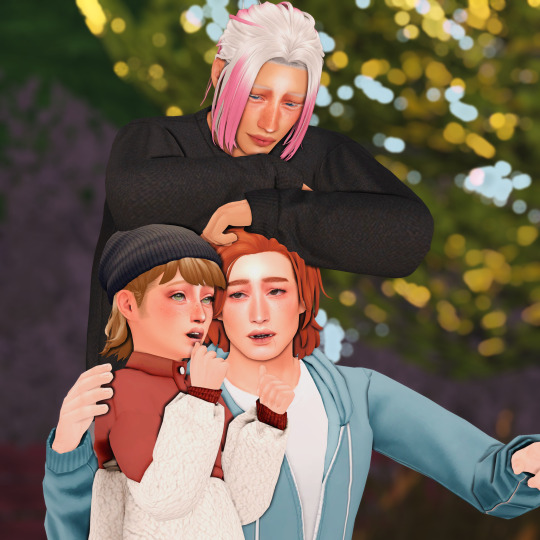
this image looks like them am i insane
#i saw it on pinterest and i was like oh god oc brainrot don’t get me now#and guess what it got me!!!#so my brain went theo BOOM vinny BOOM august BOOM#that’s just them i don’t know why or how.. it just is..#i also don’t know what’s happening during this pic of them#i’d like to imagine vinny was making fun of some decoration jenna had put up outside#and theo unintentionally started schooling him about the significance of the specific decor she put up or whatever#and vinny doesn’t care so he’s gasping dramatically and mocking theo#and august is tuning everyone out and smiling to himself cause he thinks vinny looks really stupid#yeahhh how’d i get all that from this pic? brainrot i tell you#oc: vincent#oc: theodore#oc: augustus#equi/cholia: extras
7 notes
·
View notes
Text
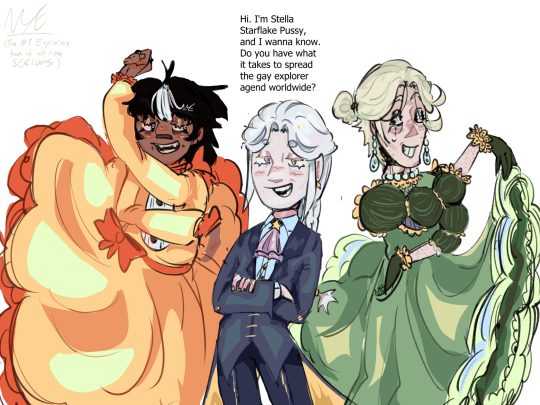
GET IT STELLA GET IT USE THOSE BOYS FOR WHAT THEY GOOD FOR
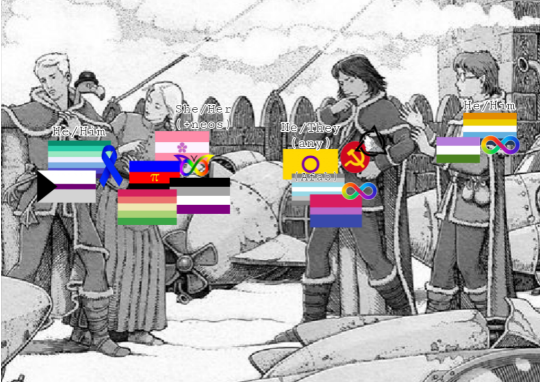
God this fandom has one great trailblazer
#The Polar Bear Explorers' Club#TPBEC#PBEC#The Ocean Squid Explorers' Club#TOSEC#OSEC#Alex Bell#Stella Starflake Pearl#Shay Silverton Kipling#Benjamin Sampson Smith#Ethan Edward Rook#Felix Evelyn Pearl#Zachery Vincent Rook#Algernon Augustus Fogg#PBEC fanart#original art#fanart#gay agenda#the explorers are gay real
8 notes
·
View notes
Text
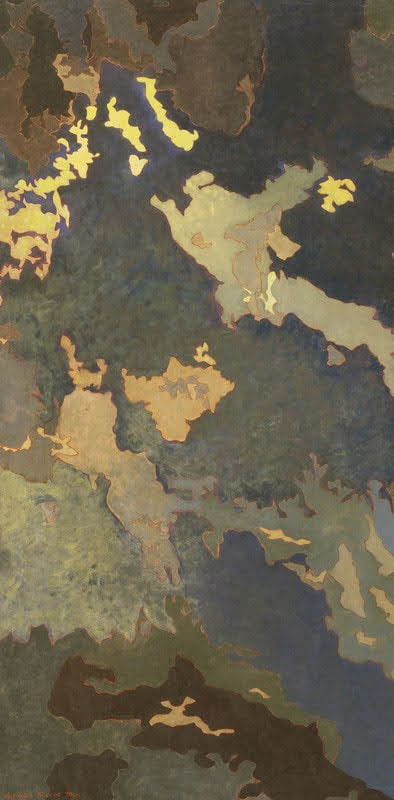
NIGHT AMARGOSA DESERT BY AUGUSTUS VINCENT TACK (1935)
11 notes
·
View notes
Text
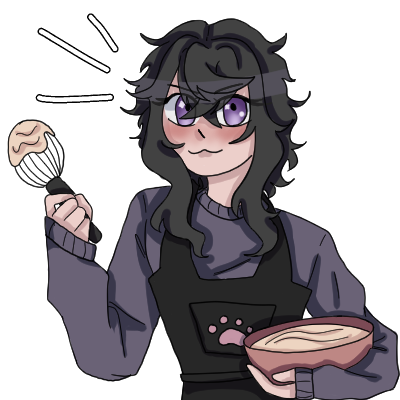
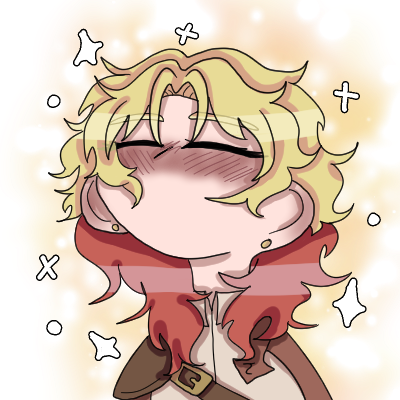






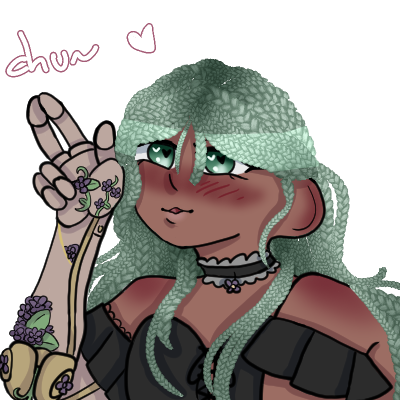

I made a BUNCH of OC iMessage stickers so here’s some of my favorites <33
#don’t mind how weird Blaire’s braids look#I for some reason decided to blend them?#I have no idea#oc#clip studio paint#digital art#oc art#illustration#original character#my art#stickers#Ryder Friedrich#Lumiere Archambeau#Meira Strauss#Abel Sotiras#Koda Aaaqil#Vincent Sotiras#Lanie Sotiras#Blaire Kapoor#Augustus König#Orchid Zheng
2 notes
·
View notes
Text
Wow, all of this history is so fascinating! I've always loved learning about things like this. Thank you so much for writing about naumachia!
Naumachia
The Naumachia, i.e. reenactments of naval battles in the arena or on artificial lakes, probably went back to Gaius Iulius Caesar 46 BC, who celebrated his military successes by presenting a battle on an artificial lake in which biremen, triremen and quadriremen with four thousand oarsmen and two thousand deckhands in battle dress took part, representing the fleets of Tyros and Egypt. The fighters involved in the Naumachia were called Naumachiarii. Like the gladiators they were mostly slaves, prisoners of war or condemned to death. Through a good performance they could fight for their freedom.
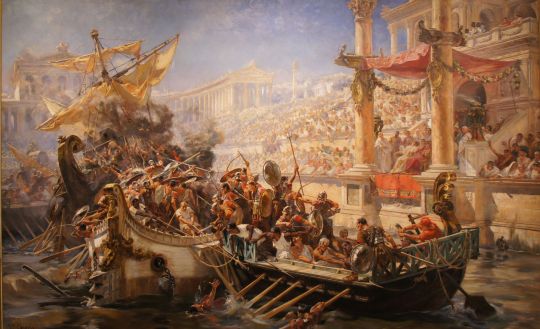
The Naumaquia, by Ulpiano Checa 1884
Augustus had a new lake built on the left side of the Tiber after the one built by Caesar had to be filled in again because of the danger of epidemics. In 2 BC, he organised a naval battle there on the occasion of the inauguration of the temple of Mars Ultor. The famous naval battle of Salamis in 480 B.C., in which the Greeks defeated the Persians, was re-enacted. The lake, which measured about 540 by 350 metres, had a small island in the middle, modelled on the bay of Salamis. Thirty birems and trirems were used, along with numerous smaller ships. In addition to the oarsmen, whose number is not mentioned in the sources, there were three thousand soldiers on board the ships.
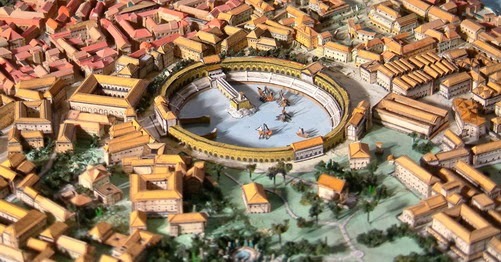
The vetus naumachia, Augustus first build permanent naumachia measuring 540 by 350 metres
The largest known re-enacted naval battle was organised by Emperor Claudius in 52 AD. On trirems and quadrirems 19000 oarsmen and soldiers fought, divided between a “Rhodian” and a “Sicilian” fleet. Before the battle, the participants, prisoners of war and slaves condemned to death, are said to have greeted Claudius with words often associated with gladiators: Ave Caesar, morituri te salutant- Hail, Caesar, the doomed ones greet you. (This greeting is generally associated with gladiators. However, there is no evidence that a gladiatorial fight ever took place in which the gladiators addressed the Roman emperor in this way.)
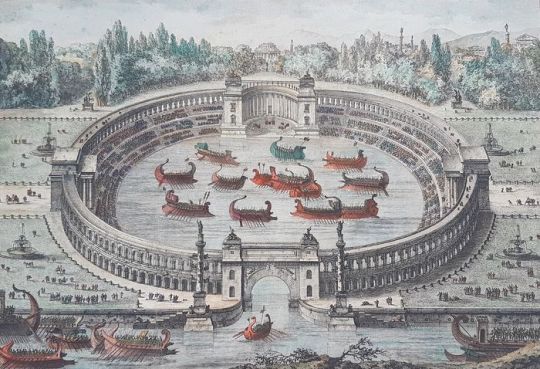
Vue et Plan d'une Naumachie, by S. Berteaux 1800
In an effort to demonstrate their absolute claim to power, the emperors wanted to make an even greater impression on the audience with naval battles integrated into the gladiator games. Caligula was a kind of pioneer in this respect, even if the basin he excavated brought him nothing but scorn, since a single ship could fit into it. Nero went a step further and had a theatre filled with water, in which a naval battle between Persians and Athenians was re-enacted, although Nero was also releasing animals like Crocodiles and other water animals (“sea monsters”) into the water. When the battle was over, the water was drained and before the ground was even dry, gladiators were competing against each other.
Emperor Titus was the third emperor to flood a Roman arena and stage a naval battle integrated into the ongoing programme of gladiator fights, all this on the occasion of the opening of the Colosseum. The spectacle in the arena was based on the battle between the Corky-ites and the Corinthians at the beginning of the Peloponnesian War. At the same time he organised a naval battle on the artificial lake that Augustus had had built on the banks of the Tiber.
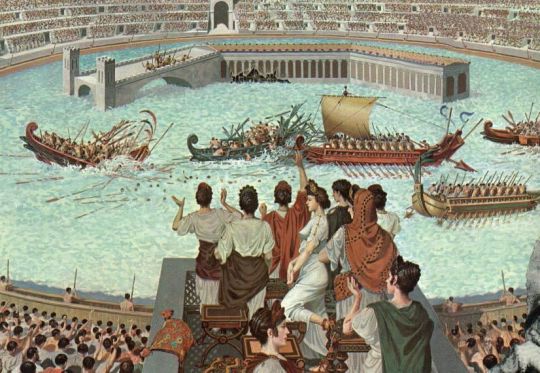
Cassius Dio writes about this: Numerous men fought as lone fighters, and quite a few groups fought with each other in land and sea battles. For Titus would suddenly fill that very theatre with water and bring in horses, bulls and other tame animals trained to behave in the water just as they would on the water. In addition there were also people on ships. They performed a naval battle there in the role of Corkieans and Corinthians, while others outside the city staged a similar spectacle in the Grove of Gaius and Lucius, in a place that Augustus had had built for this very purpose. There too, on the first day, a gladiatorial fight and an animal hunt took place, with the water in front of the pictures being covered with a wooden floor and wooden stands erected all around. The second day was followed by a chariot race and the third by a naval battle, which was followed by an infantry fight. The “Athenians” defeated the Syracuse - the name under which both parties fought at sea -, landed on the island and conquered a wall built around the monument. (from: Cassius Dio, The Roman History, Epitomy of the Book 66,25,2-4)
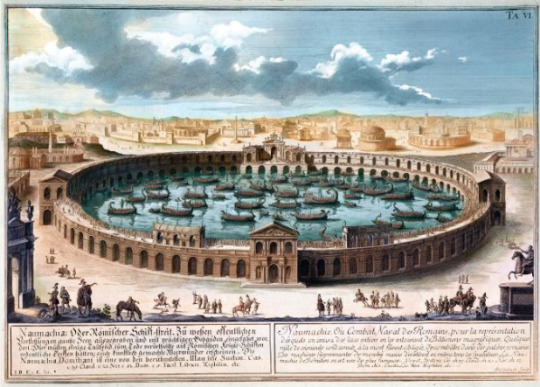
Modern historians are divided on whether naval battles actually took place in the Colosseum, despite there being ancient accounts of them. This 1721 engraving imagines one organized by Emperor Domitian in the Colosseum. Archaeologists calculated how long it would take to flood the area and came to the conclusion that it would take up to three and a half hours. so it was quite possible, although it is likely that there would only have been a small amount of water to hold an event.
Domitian made the Colosseum unsuitable for naval battles, although he had a naval battle held there before, probably to refute the claim that he could not keep up with his predecessor. Domitian had the cavity under the Colosseum converted into a hypogeum, a cell and cage block for gladiators and wild animals, spread over two floors and separated by walls and corridors. Therefore, the theatre could no longer be placed under water. Domitian, however, organised further naval battles, but at a site near the Tiber, where he had a basin dug out and surrounded by rows of seats.

The Naumaquia of 1755. Between the 12th and 13th of July 1755 and to commemorate the third centenary of the canonization of Saint Vicente Ferrer, a Naumaquia took place in the Turia river.
The last staged naval battle was probably organised by Emperor Philip Arabs in 247 AD. Nothing is known about the effort of this Naumachia, so it remains open how great the enthusiasm of the audience was.
But this type of event did not stop there. Even in the later centuries, there were still some Naumachie events to honour great deeds or other festivities. In the baroque period the Naumachia were revived for the amusement of courtly society. For example, naval battles were fought on the (now drained) Brandenburg Lake in Bayreuth, in which numerous actors were killed.
#crapsarahposts#crapsarahsays#history#historyblr#naval history#roman history#roman empire#naumachia#naumachies#gaius iulius caesar#46 bc#ulpiano checa#1884#2 bc#battle of salamis#augustus#emperor claudius#emperor nero#emperor philip arabs#247 ad#naumaquia of 1755#saint vincente ferrer#emperor domitian#cassius dio#vue et plan d'une naumachie#s berteaux#1800#art#ltwilliammowett
246 notes
·
View notes
Photo

God’s scheme of salvation as a great harbor
After a wild night, we have gone down to the harbor, over whose arms the angry waves have been dashing with boom of thunder and in clouds of spray. Outside the sea has been tossing and churning; cloud-wrack driving hurriedly across the sky; the winds howling like the furies of olden fable. But within those glorious walls, the barks which had put in during the night were riding in safety; the sailors resting, or repairing rents in sail and tackle, whilst the waters were unstirred by the storm raging without. Such a refuge or harbor is a fit emblem of salvation, where tempest-driven souls find shelter and peace.
~ F.B. Meyer
0 notes
Text
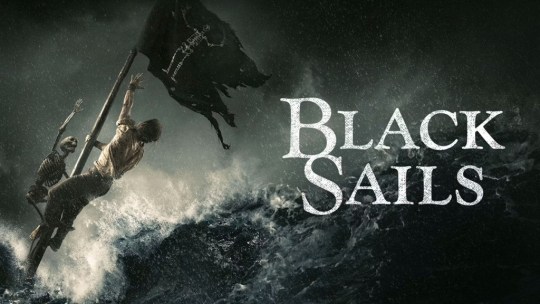

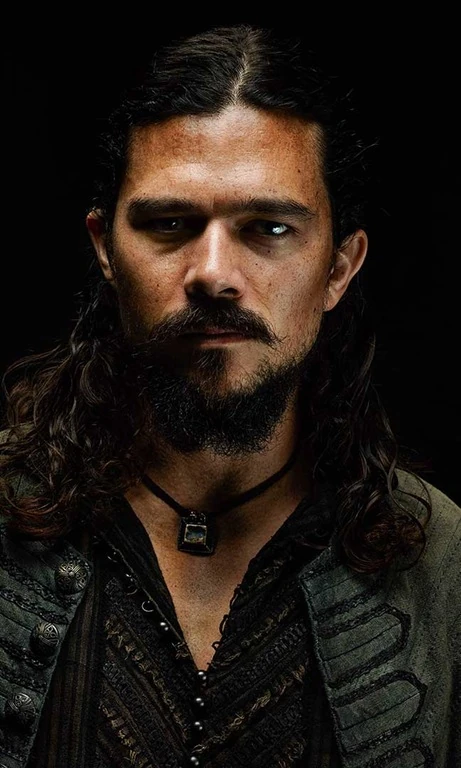
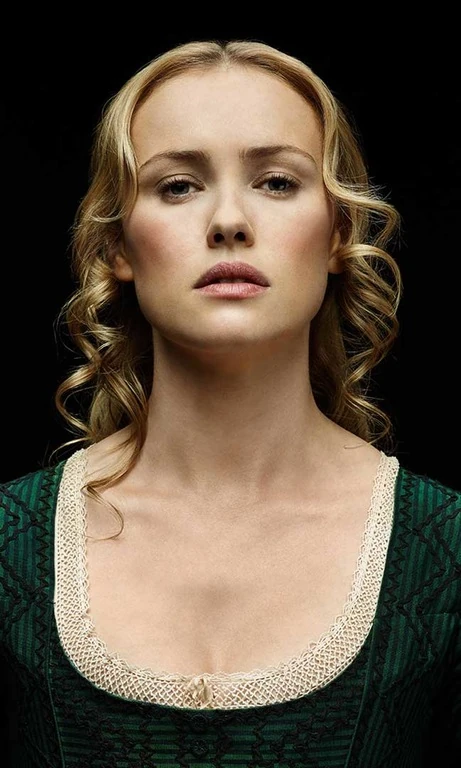
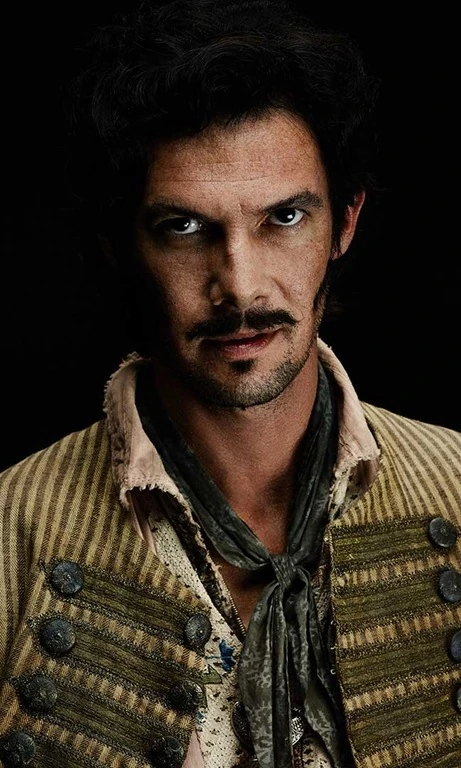



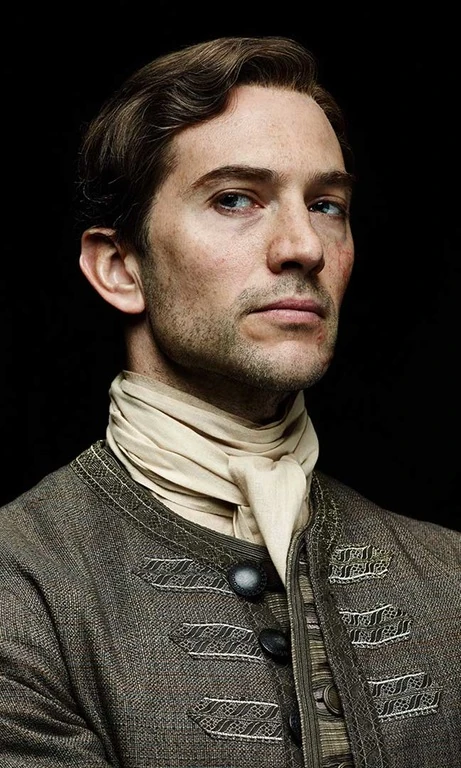


Black Sails Screen Time Breakdown
(Episode-by-episode listing at the link above)
Captain James Flint / Lt. James McGraw – 469:09 "Long" John Silver – 335:46 Eleanor Guthrie – 269:53 Captain Jack Rackham – 214:51 Max – 181:19 William "Billy Bones" Manderly – 163:57 Captain Charles Vane – 139:21 Governor Woodes Rogers – 130:52 Anne Bonny – 126:42 Madi – 84:29
Miranda Barlow / Miranda Hamilton – 83:15 Mr. Scott – 56:43 Hal Gates – 56:20 Dufresne – 48:44 Augustus Featherstone – 46:59 Captain Edward "Blackbeard" Teach – 46:03 Captain Benjamin Hornigold – 34:44 Mrs. Hudson – 34:16 Dooley – 32:43 De Groot – 29:56 Israel Hands – 29:38 Richard Guthrie – 28:07 Idelle – 22:53 Captain Berringer – 21:46 Joji – 21:36 The Maroon Queen – 20:51 Lord Peter Ashe – 20:17 Abigail Ashe – 20:14 Lord Thomas Hamilton – 17:59 Marion Guthrie – 17:50 Randall – 16:47 Ben Gunn – 15:58 Mrs. Mapleton – 15:34 Kofi – 14:57 Captain Ned Low – 14:55 Frasier – 14:26 Muldoon – 14:20 Jacob Garrett – 13:58 Pastor Lambrick – 12:52 Logan – 12:38 Eme – 11:42 Dr. Howell – 9:42 Vincent – 9:23 Jenks – 9:01 Lt. Utley – 8:50 Hamund – 8:02 Captain Bryson – 8:00 Morley – 7:51 Ellers – 7:14 Captain Chamberlain – 6:58 Soames �� 6:55 Joshua – 6:48 Obi – 6:47 Singleton – 6:34 Ruth – 6:26 Lt. Kendrick – 6:22 Zaki – 6:18 Meeks – 5:37 Julius – 5:33 Wayne – 5:23 Captain Naft – 5:20
#Black Sails#James Flint#John Silver#Eleanor Guthrie#Jack Rackham#Max Black Sails#Billy Bones#Charles Vane#Woodes Rogers#Anne Bonny#Madi Black Sails#I went with only those ten for pictures btw for visual consistency#because these stills were post S2 and therefore Miranda doesn't have one etc so the pics end at top 10#yes I count it down to the second now somebody help me#this is also why I don't do as many of these anymore for those wondering#quality over quantity#screen time stuff
129 notes
·
View notes
Text
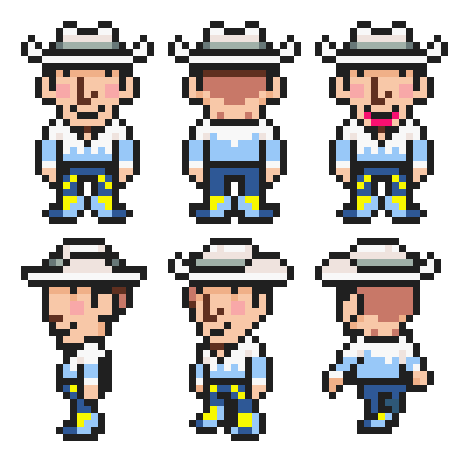

hello lgbt community
#psy's no punctuation posts#SOBR tag#mother tag#beau rudolph#vincent augustus#i'll probably make more or these but here take these cause i have to go make dinner#n don't feel like getting into another set#so simply take the boyfriends for now#also if you see any mistakes no you don't
13 notes
·
View notes
Text

ACADEMIC ID PACK

NAMES︰ adeline. agatha. alastair. alex. alexander. alexandria. alisa. amber. ambrose. ambrosia. amorette. andrew. annabel. annabeth. annalise. anya. arden. artemis. arthur. ash. ashford. aspen. athena. atlas. atreus. augustus. avery. beatrix. blair. blake. blythe. bram. bronwyn. caspian. charles. charlotte. christopher. circe. claude. coraline. crimson. damian. damien. damon. daphne. darcy. demeter. diana. dorian. durant. ebony. eden. edgar. eleanor. elenor. elizabeth. elvira. emberl. enid. eris. everett. fantine. felix. fern. genevieve. george. grey. griffin. haven. hazel. hecate. henry. hester. holmes. hyde. inkesse. inkette. inkie. inky. isolde. ivie. ivy. james. jane. journalle. julian. julius. juno. kane. killian. lenore. lilith. lorelei. luna. magnus. malachi. mallory. maude. meredith. naomi. narissa. nicodem. nightesse. nightwing. nimue. noire. noiresse. noirette. odessa. odette. oliver. ophelia. orion. percy. persephone. peyton. phineas. phoebe. quill. quille. quinn. raven. ravenesse. ravenette. ravenne. remus. romero. rory. rosalind. rose. rowan. rowena. rufus. salem. scriptesse. sebastian. stoker. sylvain. tanith. theo. theodore. theodosia. trista. tristan. victor. victoria. vincent. virgil. wilhelmine. willow. wynona. xanthe. zoltan.

PRONOUNS︰ acade/academia. amber/amber. an/antique. arch/architectself. arch/archive. art/art. art/artist. arti/article. arti/fact. artifact/artifact. baro/baroque. bea/beauty. bis/bisque. book/book. bookworm/bookworm. calligraphy/calligraphy. can/vas. candle/candle. cer/ceramic. char/charcoal. chess/chess. clas/classic. clay/clay. clock/clock. co/collect. coco/coco. cocoa/cocoa. cof/coffee. coffee/coffee. col/color. coll/collection. collage/collage. con/cept. crea/cream. crow/crow. cur/curate. dra/drama. dust/dust. essay/essay. fea/feather. feather/feather. fig/figure. fil/film. flicker/flicker. gal/gallery. glaze/glaze. globe/globe. gold/gold. hazel/hazel. his/history. history/history. hon/honey. hue/hue. hypo/hypothesis. illus/illustrate. ink/ink. journal/journal. ki/kiln. knowledge/knowledge. le/letter. learn/learn. letter/letter. li/library. lig/ligature. lit/literature. mar/marble. mur/mural. murder/murder. muse/muse. muse/museum. night/night. no/note. novel/novel. page/page. paint/brush. paint/paint. paint/painting. paper/paper. para/dox. pen/pen. pho/photo. pi/pigment. piano/piano. poe/poet. poem/poem. por/trait. porcel/porcelain. print/print. qui/quill. quill/quill. raven/raven. rea/read. read/read. ren/renaissance. rev/revolution. scrapbook/scrapbook. script/scripts. scroll/scroll. sculp/sculptor. sculp/sculpture. sketch/sketch. speci/specimen. spine/spine. sta/stamp. stai/stain. stamp/stamp. statue/statue. story/story. stu/dy. study/studie. study/study. surreal/surrealism. tea/tea. theo/theory. theory/theory. thes/thesis. time/time. tweed/tweed. violin/violin. wheel/wheel. ⌛/⌛. ⌛︎/⌛︎. ☕/☕. ✒︎/✒︎. ✒️/✒️. 🏛️/🏛️. 🏺/🏺. 📜/📜. 🕯️/🕯️. 🖼️/🖼️.

#id pack#npt#nput#name suggestions#name ideas#name list#pronoun suggestions#pronoun ideas#neopronouns#emojiself#nounself#dark academia#light academia
76 notes
·
View notes
Text





SHARPE + Incorrect quotes (Part 2)
NOTE: A quote oddly enough taken from Sharpe novels- in this case from Sharpe’s Havoc but instead of Sir Augustus asking Harper what he believes in, it’s a Portuguese officer named Vincente.
Many thanks to @e-merald-terror who was kind enough to help me find that bit!
#Sharpe#Richard Sharpe#incorrect quotes#Patrick harper#perioddramaedit#perioddramasource#my edit#thekenobeeedit#bernard cornwell#napoleonic wars#napoleonic era#Sharpe incorrect quotes#CORRECT quotes sorry#Sean bean#daragh o'malley
41 notes
·
View notes
Text
✧𖤓 Kaveh inspired names/pronouns/titles ! ⟡✧

art by x ! rq by anon !
✦•······················•✦•······················•✦
☀️ names:
alistair , amaris , ambrose , angelo , art , augustus , avery , bowie , cassidy , channing , darcy , dean , dorian , eden , ellis , erin , florian , floris , frances , harlowe , hazel , idra , idris , ira , jesse , jude , jules , keith , kel , kelsey , kendall , kennedy , kevin , kian , kiernan , kylin , laurent , leo , mckenzie , monet , noel , pax , quentin , quinn , raphael , rene , sasha , sawyer , shay , shiloh , steph , vincent , wren
🦁 pronouns:
lion/lions/lionself , gold/golds/goldself , ruby/rubys/rubyself , art/arts/artself , cher/chers/cherself , hy/hyms/hymself , ae/aers/aerself , sol/sols/solself , sun/suns/sunself , joy/joys/joyself , kind/kinds/kindself , warm/warms/warmself , arch/archs/archself , lux/luxes/luxself , luce/luces/luceself , vivid/vivids/vividself
❤️ titles:
the light of kshahrewar , the golden-haired lion , his shining artistry , he who sculpts towering cities , his paradisiacal dreams , the charming roommate , his guilty facade , he who chases idyllic dreams
prns and gendered terms may be replaced.
✦•······················•✦•······················•✦
additional tags: @eternoelle @hauntingidol @delusielle @puriette @the-astropaws @cocajimmycola
#sunrise#liom#mogai#actually mogai#xenogender#kaveh#genshin impact#kin#fictive#introject#irl#help#name list#neopronoun list#neopronouns#title list#title suggestions#name suggestions#pronoun suggestions#mogai suggestions
133 notes
·
View notes
Text
my little sister names omori characters
Omori = salisbury steak and/or tv dinner
Kel : Kevdog
Aubrey: Augustus gloop
Hero = Vincent
23 notes
·
View notes
Text

Saw this and had to do it with my characters
#clip studio paint#digital art#oc#oc art#illustration#original character#my art#meme#meme art#meme drawing#this is the future liberals want#I’m not gonna tag everyone but I’ll try#ryder friedrich#Lumiere Archambeau#Augustus König#Blaire Kapoor#Vincent Sotiras#Orchid Zheng#Meira Strauss#none of the people listed are straight#which says a lot
1 note
·
View note
Text
"One of the most unequivocal examples of patronage linking the Angevin kings and their mothers is seen in the Cistercian abbey of Notre-Dame en Voeu, Normandy. A charter from 1152 recorded the foundation by [Empress Matilda] and Henry II, and stated that she and her son created the abbey in honour of Henry I, Matilda of Scotland, and Geoffrey of Anjou, as well as for the souls of their heirs. The abbey was created after Matilda made a vow to found a new Cistercian order after the 1142 siege of Oxford. Henry II confirmed Matilda’s foundation of the abbey in a charter dating between 1170 and 1179, and placed Notre-Dame-en-Voeu under his protection in a separate charter issued between 1174 and 1182.
[Eleanor of Aquitaine] also made a grant to Notre-Dame-en-Voeu between 1189 and 1191, consisting of a portion of land from the forest of Lillebonne, part of her dower settlement, though whether this was through her own instigation or Henry’s is unknown. It is plausible she would have supported the abbey as a new site of familial patronage. John also made a grant to the abbey in 1201, which was plausibly at Eleanor’s instigation given the association of the Plantagenets with this institution. This charter, in combination with a separate grant to Bec in 1203, demonstrates the importance of Normandy to John at this critical juncture of war with Philip Augustus. This is of particular significance when contrasted with John’s activities in Normandy prior to becoming king, as highlighted by Nicholas Vincent, wherein John’s patronage of Norman institutions was scarce. Given the attention paid to Fontevraud as a familial mausolea [...] and the expanse of the Angevin dominions, it is not surprising a separate site for Angevin patronage was established with Notre-Dame-en-Voeu. Situated in the Anglo-Norman heartlands, it showed the extension of Plantagenet patronage across its domains. This example of ecclesiastical patronage shows the strength of the mother-son relationships in the Angevin domains, as both Matilda and Eleanor bound their sons to patronise a specific establishment. The motivations for doing so were to ensure dynastic security in these regions and demonstrates the co-operation and familial harmony between the three kings and their mothers."
-Gabrielle Storey, "Co-Rulership, Co-operation and Competition: Queenship in the Angevin Domains, 1135-1230", University of Winchester, PHD thesis, 2020.
#this thesis is available online and is excellent if anyone wants to read it#it has some great stuff on Berengaria of Navarre and Isabella of Angouleme as well <3#empress matilda#henry ii#eleanor of aquitaine#king john#angevins#my post#english history#queue
14 notes
·
View notes